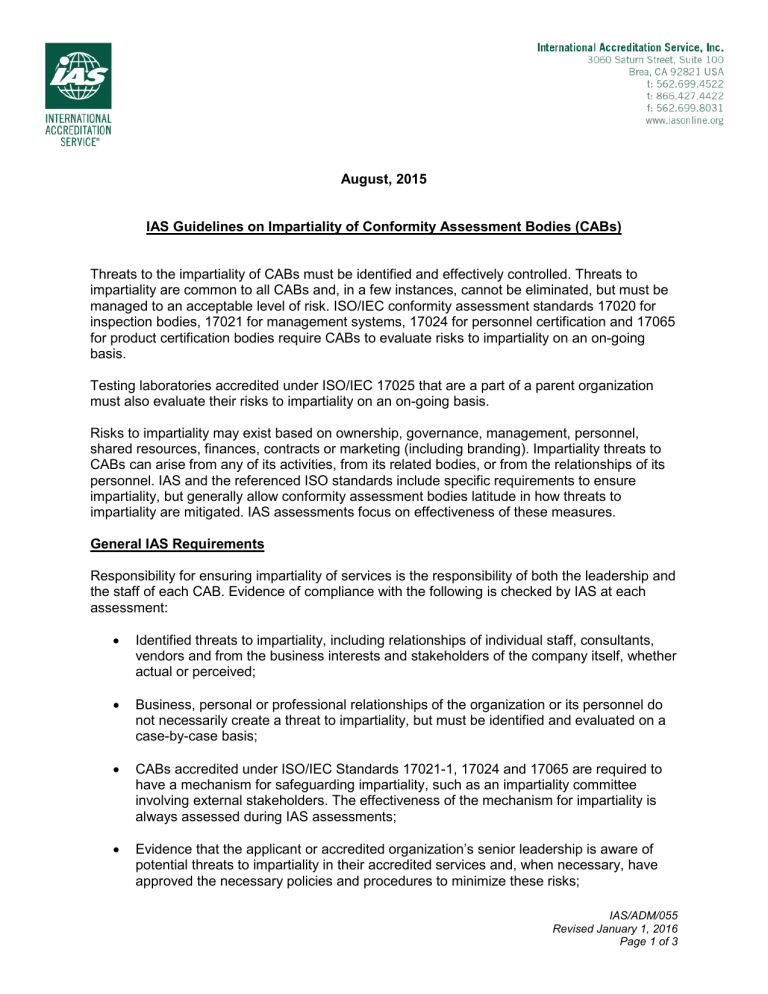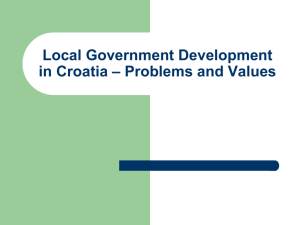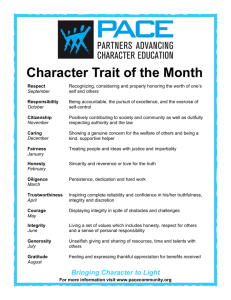
August, 2015 IAS Guidelines on Impartiality of Conformity Assessment Bodies (CABs) Threats to the impartiality of CABs must be identified and effectively controlled. Threats to impartiality are common to all CABs and, in a few instances, cannot be eliminated, but must be managed to an acceptable level of risk. ISO/IEC conformity assessment standards 17020 for inspection bodies, 17021 for management systems, 17024 for personnel certification and 17065 for product certification bodies require CABs to evaluate risks to impartiality on an on-going basis. Testing laboratories accredited under ISO/IEC 17025 that are a part of a parent organization must also evaluate their risks to impartiality on an on-going basis. Risks to impartiality may exist based on ownership, governance, management, personnel, shared resources, finances, contracts or marketing (including branding). Impartiality threats to CABs can arise from any of its activities, from its related bodies, or from the relationships of its personnel. IAS and the referenced ISO standards include specific requirements to ensure impartiality, but generally allow conformity assessment bodies latitude in how threats to impartiality are mitigated. IAS assessments focus on effectiveness of these measures. General IAS Requirements Responsibility for ensuring impartiality of services is the responsibility of both the leadership and the staff of each CAB. Evidence of compliance with the following is checked by IAS at each assessment: • Identified threats to impartiality, including relationships of individual staff, consultants, vendors and from the business interests and stakeholders of the company itself, whether actual or perceived; • Business, personal or professional relationships of the organization or its personnel do not necessarily create a threat to impartiality, but must be identified and evaluated on a case-by-case basis; • CABs accredited under ISO/IEC Standards 17021-1, 17024 and 17065 are required to have a mechanism for safeguarding impartiality, such as an impartiality committee involving external stakeholders. The effectiveness of the mechanism for impartiality is always assessed during IAS assessments; • Evidence that the applicant or accredited organization’s senior leadership is aware of potential threats to impartiality in their accredited services and, when necessary, have approved the necessary policies and procedures to minimize these risks; IAS/ADM/055 Revised January 1, 2016 Page 1 of 3 • Regular/documented management reviews that address threats to impartiality; • Defined/written policies and procedures to minimize threats to impartiality; • Documented training and agreement of staff, including the top management, on potential threats to impartiality, and approved policies and procedures intended to minimize these threats; and • Availability of services to any party without restriction. Inspection bodies that have threats to impartiality that cannot be eliminated must be accredited as either: i. Type “B” – An inspection body that forms a separate and identifiable part of an organization involved in the design, manufacture, supply, installation, use or maintenance of the items it inspects; or ii. Type “C” – An inspection body that is involved in the design, manufacture, supply, installation, use or maintenance of the items it inspects or of similar competitive items and may supply inspection services to other parties not being its parent organization. Note: Type “B” or Type “C” inspection bodies cannot be accredited as a Type A (Thirdparty) entity. Please refer to Annex A of ISO/IEC Standard 17020:2012. Impact of Organizational Structure The organizational structure of CABs can have a significant impact on an organization’s ability to maintain impartiality in its accredited services. When accredited services are provided by an organization that provides other services, including services which may be a threat to impartiality, such as design, many organizations elect to create a subsidiary corporation to provide the management of the accredited services within the organizational structure and legal authority to administer the accredited services. IAS and the ISO standards it utilizes allow CABs to provide accredited services as a division of a larger organization. In these cases, the organization must establish effective “firewalls” over certain functions between the management of its accredited services and the management of conflicting products or services. In many cases, IAS’ accreditation criteria and the referenced ISO standard provide prescriptive requirements to assure impartiality of services within this type of organizational structure. In all cases, IAS’ expectations for these “firewalls” include the following requirements: • Documented commitment of the organization’s key leadership to ethical and professional conduct in all areas of its business; • Effective “firewalls” to protect the security of confidential and proprietary data; IAS/ADM/055 Revised January 1, 2016 Page 2 of 3 • Commitment of the organization’s leadership to provide sufficient resources to the accredited division as necessary to assure impartiality of the services; • An organizational structure that defines the lines of authority and the relationship of the accredited division to other parts within the same legal entity; and • Appropriate vesting of authority to the management of the accredited body as necessary to assure the program’s impartiality. References (publications listed below refer to current editions) ISO/IEC Standard 17020 – Conformity assessment — Requirements for the operation of various types of bodies performing inspection ISO/IEC Standard 17021-1 – Conformity assessment — Requirements for bodies providing audit and certification of management systems – Part 1: Requirements ISO/IEC Standard 17024 – Conformity assessment — General requirements for bodies operating certification of persons ISO/IEC Standard 17025 – General requirements for the competence of testing and calibration laboratories ISO/IEC Standard 17065 – Conformity assessment — Requirements for bodies certifying products, processes and services **** IAS/ADM/055 Revised January 1, 2016 Page 3 of 3




